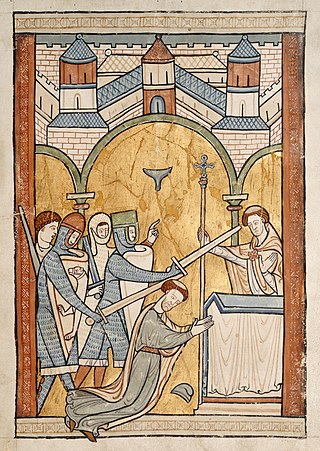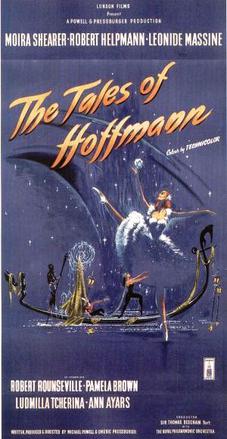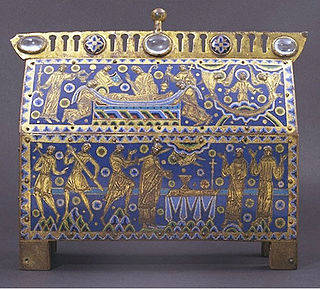Related Research Articles

Thomas Becket, also known as Saint Thomas of Canterbury, Thomas of London and later Thomas à Becket, served as Lord Chancellor from 1155 to 1162, and then notably as Archbishop of Canterbury from 1162 until his death in 1170. He engaged in conflict with Henry II, King of England, over the rights and privileges of the Church and was murdered by followers of the King in Canterbury Cathedral. Soon after his death, he was canonised by Pope Alexander III. He is venerated as a saint and martyr by the Catholic Church and the Anglican Communion.

Eldred Gregory Peck was an American actor and one of the most popular film stars from the 1940s to the 1970s. In 1999, the American Film Institute named Peck the 12th-greatest male star of Classic Hollywood Cinema.

Murder in the Cathedral is a verse drama by T. S. Eliot, first performed in 1935, that portrays the assassination of Archbishop Thomas Becket in Canterbury Cathedral during the reign of Henry II in 1170. Eliot drew heavily on the writing of Edward Grim, a clerk who was an eyewitness to the event.

The Tales of Hoffmann is a 1951 British Technicolor comic opera film written, produced and directed by the team of Michael Powell and Emeric Pressburger working under the umbrella of their production company The Archers. It is an adaptation of Jacques Offenbach's 1881 opera The Tales of Hoffmann, itself based on three short stories by E. T. A. Hoffmann.

Robert William Speaight was a British actor and writer, and the brother of George Speaight, the puppeteer.

Francis Bosley Crowther Jr. was an American journalist, writer, and film critic for The New York Times for 27 years. His work helped shape the careers of many actors, directors and screenwriters, though his reviews, at times, were perceived as unnecessarily mean. Crowther was an advocate of foreign-language films in the 1950s and 1960s, particularly those of Roberto Rossellini, Vittorio De Sica, Ingmar Bergman, and Federico Fellini.

László Lajtha was a Hungarian composer, ethnomusicologist and conductor.

The Adventures of Quentin Durward, known also as Quentin Durward, is a 1955 British historical film released by MGM. It was directed by Richard Thorpe and produced by Pandro S. Berman. The screenplay was by Robert Ardrey, adapted by George Froeschel from the 1823 novel Quentin Durward by Sir Walter Scott.

Becket is a 1964 British historical drama film about the historic, tumultuous relationship between Henry II of England and his friend-turned-bishop Thomas Becket. It is a dramatic film adaptation of the 1959 play Becket or the Honour of God by Jean Anouilh made by Hal Wallis Productions and released by Paramount Pictures. It was directed by Peter Glenville and produced by Hal B. Wallis with Joseph H. Hazen as executive producer. The screenplay was written by Edward Anhalt based on Anouilh's play. The music score was by Laurence Rosenthal, the cinematography by Geoffrey Unsworth and the editing by Anne V. Coates.
Henry II ruled as King of England from 1154 to 1189 and at various times he also partially controlled Scotland, Wales, Ireland and the Duchy of Brittany. He has been depicted in various cultural media.

The Becket Casket is a reliquary in Limoges enamel now in the Victoria and Albert Museum. It is made of gilt-copper round a wooden core, decorated with champlevé enamel, and of a shape called a "chasse". It was made in about 1180–90 in Limoges, France, and depicts one of the most infamous events in English history. On the night of 29 December 1170, Archbishop Thomas Becket was murdered in Canterbury cathedral by four knights obeying the wishes of King Henry II. It provoked outrage throughout Europe, and pilgrims flocked to Canterbury to pray at the site of the murder. In 1173 Becket was canonized and his shrine was one of the most famous in the Christian world, until its total destruction in 1538 during the reign of Henry VIII. It is thought that this particular casket was made to hold the relics of Thomas Becket that were taken to Peterborough Abbey by Abbot Benedict in 1177. Benedict had been Prior at Canterbury Cathedral and therefore saw Becket's assassination.

The Yellow Balloon is a 1953 British drama film directed by J. Lee Thompson and starring Andrew Ray, William Sylvester, Kathleen Ryan, Kenneth More and Hy Hazell. It was Thompson's second feature as director. It was distributed by Associated British and produced by the company's Marble Arch Productions. It was made at Elstree Studios with sets designed by the art director Robert Jones. Location shooting took place around Bayswater and Chelsea.
Elliott Martin Browne CBE was a British theatre director, known for his production of twentieth century verse plays. He collaborated for many years with T. S. Eliot and was first producer of many of his plays including Murder in the Cathedral.

The T. S. Eliot bibliography contains a list of works by T. S. Eliot.

Never Take No for an Answer is a 1951 British–Italian drama film directed by Maurice Cloche and Ralph Smart and featuring Denis O'Dea, Vittorio Manunta, Guido Celano and Nerio Bernardi. It is based on Paul Gallico's 1951 story The Small Miracle, about an Italian orphan boy who goes to visit the Pope.
George Michael Hoellering was an Austrian film director, producer and cinema manager. He directed Hortobagy (1936) about the Puszta in Hungary, as well as the 1951 British film Murder in the Cathedral, which he co-wrote with T. S. Eliot. He was the director of the Academy Cinema in London's Oxford Street from 1944 until his death in 1980.
St John Beverley Groser was an English Anglican priest and prominent Christian socialist. Hannen Swaffer described him as "the best-known priest in the East End [of London]" and Kenneth Leech wrote that he was "one of the most significant Christian socialist figures in twentieth-century Britain".

"Will no one rid me of this turbulent priest?" is a quote attributed to Henry II of England preceding the death of Thomas Becket, the Archbishop of Canterbury, in 1170. While the quote was not expressed as an order, it prompted four knights to travel from Normandy to Canterbury, where they killed Becket. The phrase is commonly used in modern-day contexts to express that a ruler's wish may be interpreted as a command by his or her subordinates.
Saint Thomas Becket window in Chartres Cathedral is a 1215–1225 stained-glass window in Chartres Cathedral, located behind a grille in the Confessors' Chapel, second chapel of the south ambulatory. 8.9 m high by 2.18 m wide, it was funded by the tanners' guild. The furthest left of five lancet windows in the chapel, it is difficult to view and is heavily corroded by glass oxidisation, which has made its left side especially hard to read.
Peter Strausfeld was a German-born British artist, illustrator and animator, particularly known for his film posters. For 33 years, from 1947 until his death, he created hand-printed linocut posters for each film shown at the three-screen Academy Cinema, London's leading art house cinema.
References
- ↑ "MURDER IN THE CATHEDRAL (U)". British Board of Film Classification . 29 January 1952. Retrieved 14 December 2015.
- ↑ "MURDER IN THE CATHEDRAL (PG)". British Board of Film Classification. 8 December 2015. Retrieved 14 December 2015.
- ↑ Lancia, Enrico (1998). I premi del cinema (in Italian). Gremese Editore. p. 304. ISBN 9788877422217.
- ↑ "Murder in the Cathedral (1952)". Explore Film & TV. British Film Institute. Archived from the original on 10 August 2012. Retrieved 26 September 2014.
- ↑ Eliot, T. S.; Hoellering, George (1952). The Film of Murder in the Cathedral. 24 Russell Square, London, W. C. 1: Faber and Faber Limited. pp. 13–14.
{{cite book}}: CS1 maint: location (link) - ↑ "Murder in the Cathedral (1951) - Release Info". Internet Movie Database . Amazon.com . Retrieved 14 December 2015.
- ↑ Crowther, Bosley (26 March 1952). "The Screen in Review; Eliot's 'Murder in the Cathedral,' British-Made Film, Shown at Trans-Lux 60th St". The New York Times . Retrieved 23 October 2022.